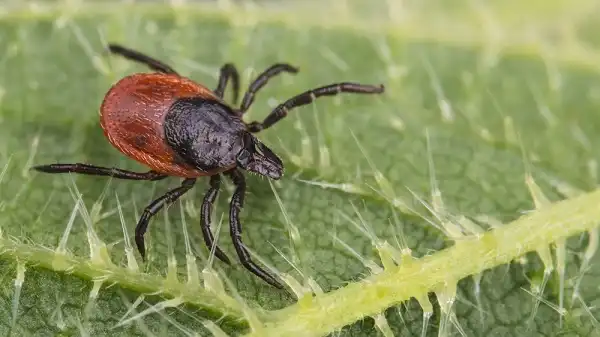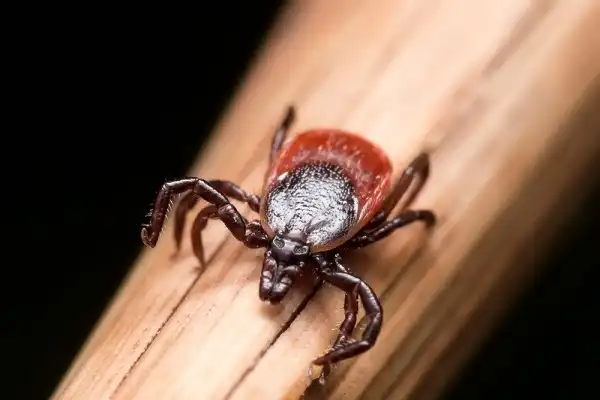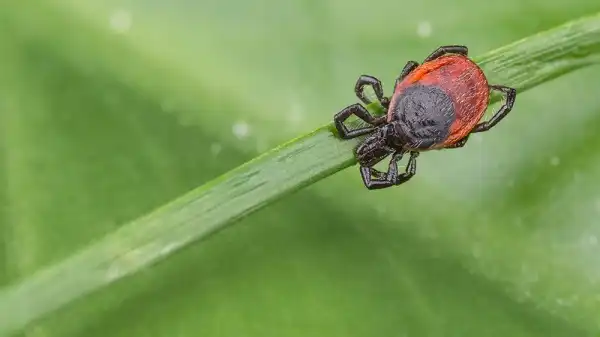Have you ever been walking through a grassy field and felt something small brush against your leg? If that feeling wasn’t entirely unpleasant, then what you most likely encountered was a deer tick. While these tiny blood-sucking parasites may seem hardly consequential to us humans, we should exercise caution when dealing with them, as some can transmit paralyzing diseases such as Lyme disease. In this blog post, I’m going to explain the ins and outs of deer ticks — where they live, how to identify them, common preventative measures one can take while out in nature, and what treatments are available if Lyme disease is suspected or contracted. It’s important to have an understanding of deer ticks since they not only affect our outdoor enjoyment but also our health!

Deer Tick Description
Deer ticks, also known as black-legged ticks, are parasitic arachnids that feed on the blood of warm-blooded hosts like deer, humans, and other mammals. They can range from light brown to dark black in color. These flat, oval-shaped creatures have eight legs and are covered in small hairs and spines. Males generally have white markings on their backs while females have yellowish-orange patches.
Fortunately, there are preventative measures one can take to avoid tick bites such as wearing protective clothing while out in nature or using insect repellants with DEET or permethrin ingredients on exposed skin or clothing. If you do find a tick attached to your body it is important to remove it as soon as possible before any disease transmission occurs by using fine-tipped tweezers and pulling gently until it completely releases from the skin. After removing the tick you should monitor yourself for any signs of infection or illness that may develop over time such as fever, rash, joint pain, or flu-like symptoms. If these occur it is best to consult a healthcare professional for further evaluation and treatment options if needed.
Deer Tick Habitat
Deer ticks are found in many parts of the world, but their main habitat is in the northern United States and southern Canada. These tiny parasites can thrive in a variety of different environments such as wooded areas, grassy meadows, or even residential neighborhoods. They tend to be more numerous during the warmer months when hosts are more abundant and temperatures are milder. These blood-sucking creatures are usually found at ground level where they wait for a host to pass by so they can latch on and feed. They prefer humid climates with plenty of shade and shelter from the elements since these environments provide them with ideal hunting conditions. Additionally, deer ticks also require regular access to water sources like ponds, streams, or puddles in order to survive and reproduce. Although deer ticks have adapted to live in a variety of different habitats, they are most commonly found in places where there are large populations of white-tailed deer since these animals serve as their primary food source.
Deer Tick Diet
Deer ticks feed on a variety of mammals, including deer, humans, rodents, and birds. Their preferred food source is the white-tailed deer as they are high in protein and fat, thus providing them with an ideal meal. However, if there are no deer present in the area, they will often turn to other hosts such as rodents or birds for their sustenance. When feeding on a host, deer ticks use their two hollow tubes located at the end of their mouthparts to attach themselves firmly to the skin. Once attached, they then proceed to slowly suck the host’s fluids until they are fully satiated.

Deer Tick Size
Deer ticks, also known as black-legged ticks, are very small arachnids that measure between 2-3 millimeters long when fully grown. They can range from light brown to dark black in color and are usually flat and oval-shaped with eight legs covered in small hairs and spines. Males generally have white markings on their backs while females have yellowish-orange patches. The mouthparts of deer ticks contain two hollow tubes that they use to attach firmly to the skin so they can feed uninterruptedly for several days.
Deer Tick Lifespan
Deer ticks have a relatively short lifespan of around 2-3 months, depending on the climate and environment. During the warmer months, they can survive for up to 3 months, while in colder climates they may only last for 2. The life cycle of a deer tick begins when it hatches from its egg and is known as a larva. It then molts into an eight-legged nymph before eventually becoming an adult. The female deer tick has the longest lifespan of all the stages, living up to 1 year while the male only lives up to 4 months. After mating, females will lay hundreds of eggs at one time in leaf litter or soil before dying off shortly after. The larvae that hatch from these eggs will begin searching for a host within 24 hours and will molt twice during their lifecycle until reaching adulthood. Aside from feeding on hosts for sustenance, deer ticks have also evolved to carry several different pathogens which are passed onto their hosts during feeding sessions. These can include bacteria such as Borrelia burgdorferi which causes Lyme disease or various viruses that can cause fever and rash symptoms.
Deer Tick Behavior
Deer ticks are known for their stealthy behavior, often remaining unnoticed until it’s too late. During the warmer months, deer ticks become more active in search of a suitable host to feed on, such as humans, birds, or rodents. They primarily concentrate around areas where there is a large concentration of white-tailed deer as these animals are an ideal food source due to their high protein and fat content. Aside from feeding on hosts for sustenance, deer ticks have also evolved to carry several different pathogens which they pass onto their hosts during feeding sessions. These can include bacteria such as Borrelia burgdorferi which causes Lyme disease or various viruses that can cause fever and rash symptoms.

Deer Tick Speed
Deer ticks are very slow creatures and usually do not move faster than 1.5 meters per hour when searching for a suitable host. They rely heavily on their sense of smell and chemicals emitted from the environment to help them locate potential food sources within their surrounding area. However, when they have successfully identified a host, they can move up to 10 centimeters per hour in order to attach themselves firmly onto the skin using two hollow tubes located at the end of their mouthparts. In addition, deer ticks may also use vibration sensing organs known as ‘hallers’ which can detect minute changes in air pressure that could signal that an animal or human is nearby. This allows them to quickly orient themselves towards a potential food source and latch onto it before any further movement is made, enabling them to remain attached for extended periods of time without being noticed due to their small size.
Deer Tick Hunting
Deer tick hunting is a necessary activity for anyone spending time outdoors in areas where these creatures may live. There are several ways to hunt for deer ticks, including using insect repellent with DEET or permethrin to keep them away from exposed skin or clothing, wearing protective clothing while out in nature, and performing regular inspections on your body and clothing. Additionally, deer ticks can also be collected by dragging a white-flannel cloth along the ground around tick-prone areas. This method is known as ‘dragging’ and is typically done at the edges of wooded areas and brushy fields where deer ticks tend to congregate. Once collected, it is important to identify the deer ticks correctly so that proper measures can be taken to deal with any potential illnesses that could result from their bites. Deer ticks are small and can often appear similar to other types of arthropods such as spiders or mites. Important marks to look out for when identifying a deer tick include its flat back, pale front legs, and striped pattern on its abdomen.

Conclusion
Deer ticks are a common pest in many parts of the world and can pose serious health threats to people and animals who come into contact with them. These creatures have adapted over time to become very stealthy in their behavior, often remaining unnoticed until it’s too late. They primarily concentrate around areas where there is a large concentration of white-tailed deer as they provide an ideal food source due to their high protein and fat content.
Frequently Asked Question


